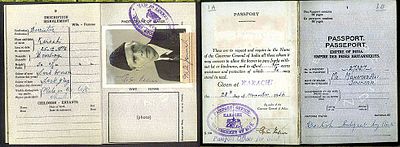British Indian passport


The British Indian passport was a passport, proof of national status and travel document issued to British subjects of the British Indian Empire, British subjects from other parts of the British Empire, and the subjects of the British protected states in the Indian subcontinent (i. e. the British Protected Persons of the 'princely states'). The title of the state used in the passport was the "Indian Empire",[1] which covered all of India, Pakistan, Bangladesh, and Burma.
The use of the passport was discontinued after the independence of India and Pakistan in 1947, and its bearers were entitled to opt for Indian, Pakistani or British nationality.
Pre-1947 History[edit]
The use of passports was introduced to the British Raj after the First World War.[2]
The Indian Passport Act of 1920 required the use of passports, established controls on the foreign travel of Indians, and foreigners travelling to and within the Presidencies and Provinces of British India.[3] The passport was based on the format agreed upon by the 1920 League of Nations International Conference on Passports.[4]
Related pages[edit]
- Indian passport
- Pakistani passport
- Indian nationality law
- Pakistani nationality law
References[edit]
- ↑ "Dominions 1931-1947". Historical Atlas of the British Empire. Archived from the original on 22 December 2015. Retrieved 16 December 2015. Unknown parameter
|url-status=ignored (help) - ↑ MumbaiSpace Indian Passport History Archived 6 October 2010 at the Wayback Machine
- ↑ Passport (Entry into India) Act, 1920 (No. 34 of 1920)
- ↑ "History of Passports". Archived from the original on 15 April 2009. Retrieved 23 February 2009. Unknown parameter
|url-status=ignored (help)
Other websites[edit]
![]() Media related to [[commons:Lua error in Module:WikidataIB at line 466: attempt to index field 'wikibase' (a nil value).|Lua error in Module:WikidataIB at line 466: attempt to index field 'wikibase' (a nil value).]] at Wikimedia Commons
Media related to [[commons:Lua error in Module:WikidataIB at line 466: attempt to index field 'wikibase' (a nil value).|Lua error in Module:WikidataIB at line 466: attempt to index field 'wikibase' (a nil value).]] at Wikimedia Commons
| This Europe-related article is a stub. You can help EverybodyWiki by expanding it. |
